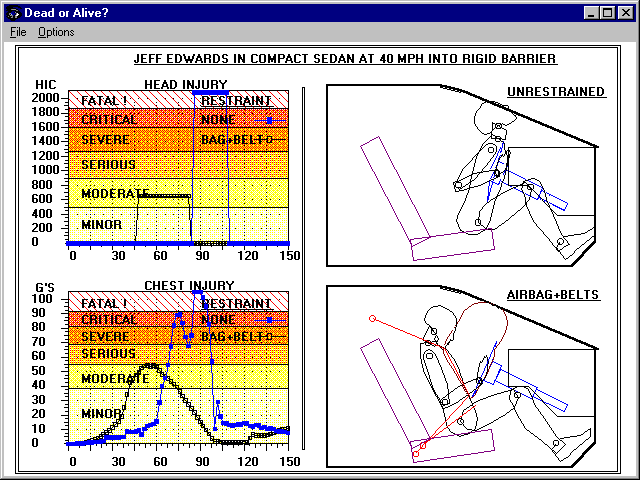Lesson #2: Emergency braking
How can a vehicle shorten it's stopping distance in an emergency
Whoa! In our Safety Introduction we implied that stopping too fast is what kills people and now we want to figure out how to stop "quicker"? Something is wrong here! Sure is. We haven't as yet discussed what level of deceleration humans can safely sustain and not be injured.
It turns out that the deceleration rates that are safe for humans is much higher than ever possible to ever achieve with the available friction between rubber tires braking on asphalt or concrete. The California Department of Motor Vehicles stopping distance tables are based on 1/2 g of deceleration. Humans can take 15 g's for a short pulse with no injury as shown in the chart below. People even pay money to ride roller coasters that subject them to as much as 8 g's. NASA data also shows that 6 g's deceleration (eyeballs out) can be sustained for 4 minutes (240 seconds).
Reference: Fundamentals of Personal Rapid Transit by Jack H. Irving, Lexington Books, 1978. Figure 6-12. Deceleration Tolerances for Short Duration Impulses When Using Various Body Restraint Systems, p. 189. Skytran vehicles will be designed to decelerate at 6 g's by including a hydraulic disk brake (for extremely rare emergency use only) that instead of squeezing hard against the spinning rotor attached to a car's axle, will squeeze against a continuous steel rib that is inside our hollow guideway. Thus, no longer will emergency braking be limited by the traction capabilities of rubber tires on asphalt or concrete! This SkyTran emergency braking feature has tremendous safety implications as shown in the table below.
DECELERATION LEVEL IN g's
VEHICLE TYPE
CONDITION
DISTANCE TO A COMPLETE STOP FROM 100 MPH
TIME TO STOP FROM 100 MPH
.125 g
(1/8th g)TRAINS
People Standing in Aisles
2,670 feet
(1/2 mile!)36.4 seconds
0.4 g's
CARS
Normal Hard Braking
835 feet
11.4 seconds
0.7 g's
"
Skilled Hard Braking
477 feet
6.50 seconds
1.0 g's
"
Clean Dry Road, Best Tires
333 feet
4.55 seconds
6.0 g's**
SkyTran
Grips Track
55.6 feet
.759 seconds
15.0 g's
ZERO INJURY SAFETY THRESHOLDS
Seatbelt Only
22.2 feet
.303 seconds
25.0 g's
"
Full Torso restraint
13.3 feet
.182 seconds
60.0 g's
"
Air Bag + Full Torso Restraint
5.5 feet
.075 seconds
(** It is important to point out that NASA data shows the limits for humans to sustained 6.0 "g" decelerations (eyeballs out direction) is 4 minutes (240 seconds) for performance and 5 minutes (300 seconds) under emergency conditions. The extremely rare SkyTran 6 "g" emergency deceleration from 100 MPH is all over in less than 1 second! This is a short duration impulse rather than a sustained deceleration level.)
Click HERE for more interesting, though semi-technical information about deceleration levels and crumple zone distances.
Whoa, Man! Are you seriously trying to tell me my body won't be wrecked and my brain be scrambled if I am subjected to 6 "g's"?
Hardly!You are serious? SkyTran might subject a little old lady who wants to go shopping to 6 "g's"? Seems CRAZY!
The 6 g's is only for the super rare emergency stop and enhanced safety. Here is an opportunity to cheat the current automobile limitations of the coefficient of friction between rubber tires and asphalt. We would be remiss if we didn't take advantage of the physics. If 6 g emergency deceleration capability was available for the car your Mom (or teenage daughter) drives would you recommend she turn it off cause the g's might hurt her?That could easily mean she crashes instead! At 60 mph, having a 6 g deceleration capability means Mom would get stopped in just 20 feet from the instant she hit the brakes, instead of 300 feet or so with an automobile. Too bad I'm not smart enough to figure out how to do that for cars. Cars with those super 6 g brakes would do a lot less crashing into kids, flying off cliffs, rear ending each other, etc.
Crash Simulation Experiments. For realistic insight into SkyTran's proposed controlled, steady 6g deceleration we can use auto crash simulation software. As shown below one can select a choice of car, restraint system, impact velocity, etc. The software animation then shows what will happen to the driver while simultaneously showing the build up of g's versus time.
The software provides a terrific visual education! Kids love watching these animations progress in slow motion and Mom's cringe watching them. (The abbreviation "HIC" in the HEAD INJURY graph below means "head impact criteria", a special term used by crash safety engineers.) This software should be made available free to high schools all over the country, so young people could better understand why wearing seat belts and shoulder harnesses makes so much sense.
The above software simulates crashing and the results of an impact, whereas SkyTran in extreme emergency situations only intends to use a steady 6 g's deceleration to slow the the vehicle down fast in order to completely avoid any crash impact. We want to again emphasize that decelerations under 15 g's means no harm to the properly restrained human.
Lastly, please consider just how many of the 40,000 people who get killed on our nations highways every year would still be alive - if cars could really stop super fast - at 6 "g's" instead of 0.4 "g's" (15 times the stopping power).

